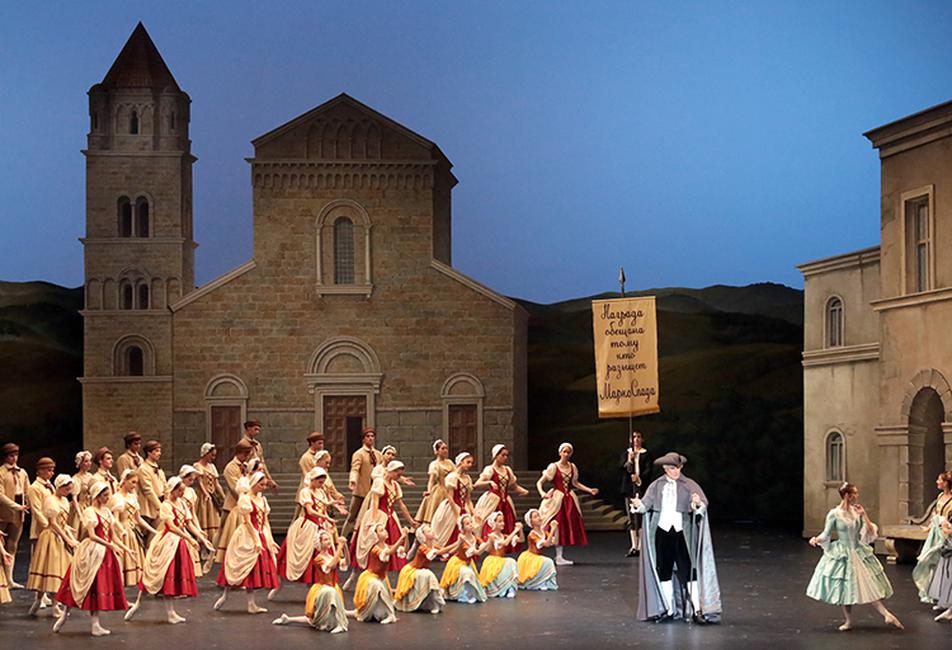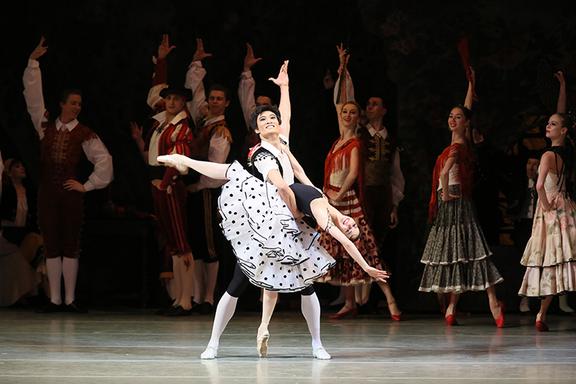
The Bolshoi is bringing the ballet Marco Spada back into its repertoire. The first performance series will be held at the Historic stage of the theatre from the 14th- 18th of June. Marco Spada became the second work of a wonderful French choreographer at the Bolshoi Theatre, a connoisseur and restorer of ballet relics of the past, Pierre Lacotte. Unfortunately, he passed away quite recently, and the renewal of the ballet will be realised without his participation and inspiring presence. However, his memory is alive at the Bolshoi, and this performance will be yet another evidence of it.
In 1981 Pierre Lacotte, who had revived several forgotten ballets by then, recreated Marco Spada for the ballet troupe of the Teatro dell'Opera di Roma. The leading part was intended for Rudolf Nureyev, who, although he was no longer in his best shape, could still qualify for roles that were by no means of just mime quality. And in the environment of the old ballets, male roles gained not only narrative, but also choreographic significance.
An Italian bandit, Marco Spada, was brought to ballet by the opera of the same name. Its premiere took place in 1852 at the Paris Opéra-Comique. The music was composed by the eminent and prolific Daniel-François-Esprit Auber, the libretto was written for him by the famous dramaturgs Eugène Scribe and Germain Delavigne, who had often worked together, including for Auber. The creative solution for the final scene was based on Horace Vernet’s artwork La Confession du bandit.
According to the legend, the impetus to create a choreographic canvas from the life of an opera bandit came from a playful idea of Emperor Napoleon III to bring together in one ballet two then-stars of the Parisian ballet scene naturally competing with each other — the Italians, Carolina Rosati and Amalia Ferraris. Eugène Scribe undertook the task to transform the opera libretto into a ballet one precisely because there were two ladies who participated in its plot twists. However, the ballet Marco Spada ou La Fille du bandit owes its music not to the opera that had originated it. Moreover, the change in genre also caused changes in the clashes of the plot. The score of his one and only full-length ballet, Auber put together like a mosaic taking the best numbers from his other operas (Le Concert à la cour ou la Débutante, Fiorella, La fiancée, Fra Diavolo, Le lac des fées, L'ambassadrice, Les diamants de la couronne, La barcarolle, ou L’amour et la musique, Zerline, ou La corbeille d'oranges and L'enfant prodigue).
Auber’s operas contributed to the development of technical equipment of the Académie Royale de Musique (later called the Paris Opera), since their productions required various special effects that excited the audience’s imagination. The plot of Marco Spada was no exception, and this also spoke in favour of its return onstage in a ballet hypostasis.
The choreographic outline, according to which two rival ballerinas and their partners embroidered their steps (the role of Marco was performed by an artist of the mime genre), was woven by Joseph Mazilier, also an Italian, born Mazarini, who became famous for being the first performer of the role of James in La Sylphide by Taglioni father and daughter and the author of the legendary ballets Paquita and Le Corsaire, which, of course, subsequently have experienced a number of rebirths, but they still owe the very fact of their genesis to him.
In 1851 Mazilier set off for St Petersburg, the route well-trodden by his fellow citizens, but the very next year he returned to accept his appointment as chief choreographer of the Académie / Paris Opera (1853-60). (In the year of the premiere of Marco Spada’s ballet version, Auber would also receive a promotion — he would be appointed court composer).
The ballet was a success and sustained a number of performances that would not be considered insignificant at that time, however, following Rosati, who wished to demonstrate her talent at the St Petersburg Imperial Theatre as well, it left the Paris stage.
“The renewal of Marco Spada realised by Lacotte became an important event. It resurrected that charming period of Italian history of the end of the 18th century when “bandits” were the only protectors of peasants from the established governments. In their stage life, those desperate and often heroic defenders of peasantry are distinguished by almost the same charm and perform almost the same functions as the American cowboys in early Hollywood Westerns. Marco Spada is also important because it revives a no less charming variety of dance theatre – pantomime ballet. Lacotte created his version of the ballet by painstakingly following the historic documents — the libretto, score, inventories, pictures, sketches, caricatures, reviews and other literary sources…” — that is how the prestigious Dance Magazine responded to the Rome premiere of the ballet (Dance Magazine № 11, 1981).
The ballet attracted the attention of the world of ballet and gained huge success. In 1982 a recording was made with the participation of the leads of the premiere — Nureyev, Ghislaine Thesmar and Michael Denard. While in 1984, during the first season of his heading of the Paris Opera, Nureyev demanded it be part of the repertoire of this renowned troupe, where several splendid artists joined the collection of the leading parts’ performers. In 1986 Pierre Lacotte staged this ballet in Monte Carlo, and in 1994 — with the troupe he headed at the time, the Ballet National of Nancy and Lorraine, where the leading part was performed by Andrei Fedotov, whose artistic career started with the Bolshoi Ballet.
The premiere at the Bolshoi was held in 2013 with the participation of the leading artists of the troupe and a guest principal – “resident” David Hallberg, who became one of the dancers in the main part.
“One should not look for authenticity of experience or psychological truth in this story. Pierre Lacotte gives the audience pure rejoicing and enjoyment of skill. <…>
His three pillars are irony, grace and taste. It might be to the detriments of temperamental Moscow’s dear tempest and onslaught. But the master and his assistants, Anne Salmon and Gil Isoart, achieved the absolute integrity of the performance, the full inclusion of the artists in the game and the cantilena of the dance. There is no impression here, which has been common in recent times, as if a performer is not dancing, yet, falling out of action every now and then, while busily passing from one demanding step to another. The effort is invisible. On the other hand, the pleasure this work gives them is clear and obvious. One might wonder what our artists can and cannot do. They can dance anything – Kvartira by Mats Ek, Wayne McGregor’s Chroma or a stylisation of the gallant era. All they need is people to work with them in a talented and professional way, with a sincere interest in the artistic result” (Nezavisimaya Gazeta, 11.11.2013).
The first performance series this year will be held on the 14th –18th of June.

